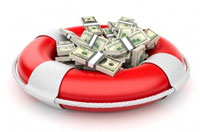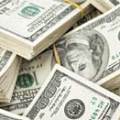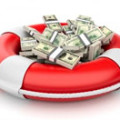You said the flood wouldn’t reach your basement, but it did. You thought you’d never get laid off from your job, but it just happened. You thought you could avoid car accidents for your whole life, but your car got totaled.
The world of finance can be a dark and uninviting place, but if there’s one thing that’s certain, it’s that good financial planning for the future will always benefit you. An essential part of financial planning is having an emergency fund.
An emergency fund is money that you save in order to help you through the tough breaks that life might hand you. It sits dormant until it’s ready to be used. While it may feel excruciating to put money away toward this fund, you’ll feel relieved in the long run when you know you have money to fall back on.
Just how can you go about establishing your own emergency fund? Here’s five important tips to get you started.
Set an Attainable Target
An emergency fund, when it all comes down to it, is basically built on setting a goal. Unfortunately, many people tend to bite off more than they can chew when it comes to goal-setting. Say you want to exercise more, so you decide to go to the gym every day for five hours. Sounds rigorous and a bit impossible, right?
Setting a high savings goal is the same way – you may want to accumulate enough to have a year’s worth of emergency savings, but it takes more time and commitment than you think. Set your first target low. Take small steps from there.
A good starting point is to have a fund of anywhere between $200 and $500. It’s a fund that can be reached within a matter of months, but would be enough to get you out of a sticky situation quickly.
Again, sky-high goals never work, so it’s best to break them down into smaller pieces. In order to get your initial emergency fund up to par, consider saving between $25 and $40 a week. To put it into perspective, putting away $25 would easily bring you more than $200 in 10 weeks.
Cut Out the Money Wasters
You probably don’t even think you have the money to start creating your emergency fund. However, you spend money more often than you think, and there’s several things you can do to snatch up that money flying out the window. So stop digging around in the couch cushions and looking under the furniture.
We all waste money on things we don’t need. It’s time to take a hard look at where you’re spending money each month. Once you figure out what is sucking up your precious earnings, you can decide what can stay and what needs to go for a while. Here’s a list of some common expenses, and what you can do to adjust them.
- Heating and cooling – To fix this, you can install a programmable thermostat that can be turned off when you’re sleeping or at work. This will cut your monthly bill by 20 to 30 percent.
- Groceries – Don’t go to the store hungry. Believe it or not, many grocery bills end up being more than we expected because we buy things we just don’t need.
- Driving – Gas may be getting cheaper, but you probably still fill up the car frequently. There are many ways to cut these costs. You could carpool, use public transportation or even ride a bike.
- Anything else – Be honest: How many times have you discovered you have money and decided to spend it on something right away? Instead of splurging on that takeout or that outfit, put it in the bank.
Automatic Is the Way to Go
What’s worse than spending found money is watching it sit on the table and knowing you can’t spend it. Want to know a quick fix for this? Set up a savings plan at your bank that has automatic deposit. That means any amount of money you choose gets transported from your checking to your savings account without you having to see it. It’s almost like magic!
If you really think you need to be kept away from that money, set up the savings plan at a different bank. That will make the money less tempting and convenient to get to, because you’ll have to sit at your computer, complete a transfer and wait a few days. As an added bonus, it might expose you to banks with good service and rates.
Remember your initial plan when deciding what amount to swipe from your checking account.
Celebrate Milestones
Knowing that you have money to fall back on is a relief. When you hit that first savings milestone, it will lift a weight off your shoulders. This is a proper time to congratulate yourself on a job well done!
For each milestone, reward yourself. It’s one of the best parts of setting a goal. You know you’ll have a reward down the line for each increment you complete. Just don’t pat yourself on the back too much – keep the rewards small. A new outfit, a night at a restaurant or a book are some good examples.
Stick to It!
What good is an emergency fund with only $50 in it? You have to stay serious about this. Remember, at any time, you could be in a tough spot where you’ll need cash quickly. Sticking to your plan is probably the toughest part of creating an emergency fund, but when you keep your goals attainable, it makes things much easier.
5 Tips to Help Jump Start Your Emergency Fund – Final Thoughts
Think of it in terms of something we can all relate to: food. We all have to eat and drink. This emergency fund will get you the necessary items you need to survive, should you find yourself in an unlucky bind – but you should at least have a place to stay, too.
Now go forth and save yourself with the power of saving!
Anum Yoon is a personal finance blogger and writer. She created and maintains her personal finance blog Current on Currency. You can subscribe to her blog newsletter right here for her weekly updates.










Automatic savings is the way to go! Out of sight, out of mind. Great article!
Kelly @ Brainy Chick Finance recently posted…How Often Should I Be Checking My Financial Accounts?
Thanks Kelly – I agree. Automatic savings helps so many people each and every day!
I think another useful tip is to automatically add any “extra” money to the fund! Bonuses, gifts or other unexpected sums of money should be put directly in the fund, not spent!
Frank,
That’s a great upgrade. I agree that any “extra” money like bonuses, windfalls, etc. are great to put straight into the emergency fund!